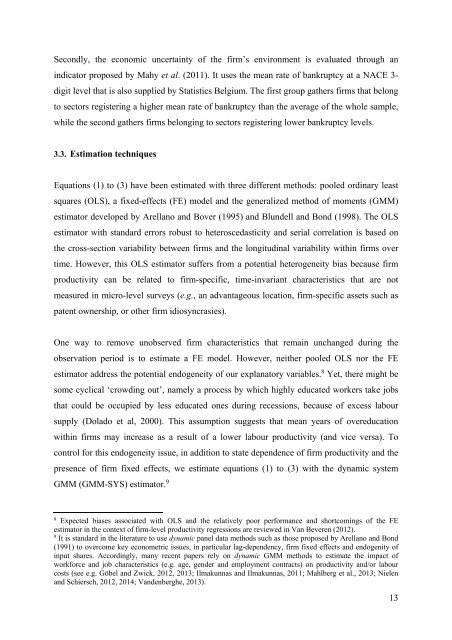CEB Working Paper
240798&r=lma
240798&r=lma
You also want an ePaper? Increase the reach of your titles
YUMPU automatically turns print PDFs into web optimized ePapers that Google loves.
Secondly, the economic uncertainty of the firm’s environment is evaluated through an<br />
indicator proposed by Mahy et al. (2011). It uses the mean rate of bankruptcy at a NACE 3-<br />
digit level that is also supplied by Statistics Belgium. The first group gathers firms that belong<br />
to sectors registering a higher mean rate of bankruptcy than the average of the whole sample,<br />
while the second gathers firms belonging to sectors registering lower bankruptcy levels.<br />
3.3. Estimation techniques<br />
Equations (1) to (3) have been estimated with three different methods: pooled ordinary least<br />
squares (OLS), a fixed-effects (FE) model and the generalized method of moments (GMM)<br />
estimator developed by Arellano and Bover (1995) and Blundell and Bond (1998). The OLS<br />
estimator with standard errors robust to heteroscedasticity and serial correlation is based on<br />
the cross-section variability between firms and the longitudinal variability within firms over<br />
time. However, this OLS estimator suffers from a potential heterogeneity bias because firm<br />
productivity can be related to firm-specific, time-invariant characteristics that are not<br />
measured in micro-level surveys (e.g., an advantageous location, firm-specific assets such as<br />
patent ownership, or other firm idiosyncrasies).<br />
One way to remove unobserved firm characteristics that remain unchanged during the<br />
observation period is to estimate a FE model. However, neither pooled OLS nor the FE<br />
estimator address the potential endogeneity of our explanatory variables. 8 Yet, there might be<br />
some cyclical ‘crowding out’, namely a process by which highly educated workers take jobs<br />
that could be occupied by less educated ones during recessions, because of excess labour<br />
supply (Dolado et al, 2000). This assumption suggests that mean years of overeducation<br />
within firms may increase as a result of a lower labour productivity (and vice versa). To<br />
control for this endogeneity issue, in addition to state dependence of firm productivity and the<br />
presence of firm fixed effects, we estimate equations (1) to (3) with the dynamic system<br />
GMM (GMM-SYS) estimator. 9<br />
8<br />
Expected biases associated with OLS and the relatively poor performance and shortcomings of the FE<br />
estimator in the context of firm-level productivity regressions are reviewed in Van Beveren (2012).<br />
9<br />
It is standard in the literature to use dynamic panel data methods such as those proposed by Arellano and Bond<br />
(1991) to overcome key econometric issues, in particular lag-dependency, firm fixed effects and endogenity of<br />
input shares. Accordingly, many recent papers rely on dynamic GMM methods to estimate the impact of<br />
workforce and job characteristics (e.g. age, gender and employment contracts) on productivity and/or labour<br />
costs (see e.g. Göbel and Zwick, 2012, 2013; Ilmakunnas and Ilmakunnas, 2011; Mahlberg et al., 2013; Nielen<br />
and Schiersch, 2012, 2014; Vandenberghe, 2013).<br />
13


